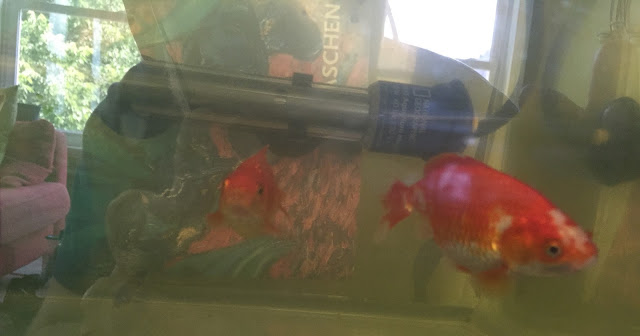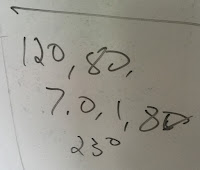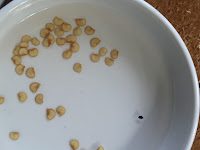Cloudiness
After writing
The Show So Far entry this morning, it suddenly occurred to me that the cloudiness of the water was most likely due to
algae. After reading some material about what to do, it seems that it's a normal part of the process when you're starting up a tank. I already knew that having a tank in daylight conditions would make it an issue anyway.
After weighing my options, I'm going to let it ride for a little, but will probably get some snails to try to keep the tank in better balance. At first, getting a Pleco fish seemed like a wonderful idea, but thought better of it as I discovered that you need to keep feeding them algae tablets when there is no longer any algae in the tank. I'm thinking that some snails would be the less voracious option.
I'm also thinking about how to best cover the tank when we're not in the room. I thought about creating some kind of stage curtain. For whatever reason, it reminded me of this kitschy jukebox at this 24-hour greasy spoon called the
Anchor Grille. For every song that plays, the curtain opens, revealing a big band made up of figurines. The figures actually move to the music although I don't recall if they actually moved to the beat. To make it even more hilarious, they placed Ken and Barbie dolls in front as the two singers. I couldn't stop laughing the first time I saw it.
 |
| The Anchor Grill Jukebox Band |
Ammonia Explosion
So, I performed an afternoon ammonia check because of the alarming 2.0 ppm rate this morning. I was shocked that it jumped even further to 4.0! I acted upon the situation by performing a 20% water change and a supplement of pH UP to counter the lower pH of the replacement water (w/ a drop of dechlorinator). It continues to be an emergency situation until I can get the ammonia to a reasonable level. Otherwise, the fish will die. Let me do this now while I'm writing this...and I'm back.
The ammonia is down to 2.0 ppm, but it's not good enough. I want to bring it to 1.0 and then let the bacteria do the rest. It's a kind of damned-if-you-do/damned-if-you-don't scenario because for each water change, I dilute the ammonia but I also dilute the bacteria necessary for creating a balanced system.
The sudden prompting for an ammonia check was spurned by the behavior of the fish, as they were swimming a little erratically to me. It caused me to wonder if the ammonia was affecting them. Since 2.0 ppm is too high of a level for them, I guessing this is why. On the other hand, in my previous five gallon, traditional aquarium, the fish would do this after a water change, but then calm down. I will perform another ammonia check this evening.
Aerator
Since the algae problem had surfaced, and algae eat the oxygen needed by the fish, I needed to get an aerator sooner than I wanted. It suddenly dawned on me (twice), that my wife had an aerator that he attempted to give to her father, way before we met, but he rejected the present because he couldn't use it. It's really meant for a bucket of fish you've caught; after you've actually went fishing, but it's the same thing. I dug it out of my workbench area (the crapé room), plugged in some "D" batteries, and fired her up. It's working great so far.
Seeding
I'm going to soak the seeds I purchased for the growbed for a day to increase their chance for survival. I'm going to retry the varieties which killed the first time around, including: chive, basil, and jalapeño peppers. I'm also soaking the lemongrass seeds to place them in the growbed, but only for propagation purposes. They will later be transferred to a pot for mosquito-shooing and seasoning.
The lemongrass will come in handy when I make a banh mi hero from
The Banh Mi Handbook. I received it as a gift from the
Chef'd meal store. I feel guilty for not trying them yet. The french bread recipe looks so great!
Well, that's it for this evening. I'll do the rest of the readings tomorrow and let you know how it's doing.



































